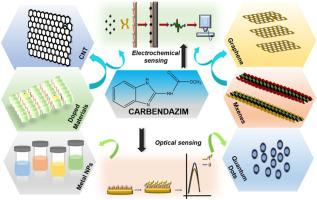Trends in Environmental Analytical Chemistry ( IF 11.1 ) Pub Date : 2021-07-08 , DOI: 10.1016/j.teac.2021.e00137 Indhu Suresh 1, 2 , Stalin Selvaraj 1, 3 , Noel Nesakumar 1, 3 , John Bosco Balaguru Rayappan 1, 2 , Arockia Jayalatha Kulandaiswamy 1, 2

|
Carbendazim sensors with high sensitivity and selectivity have become imperative for the welfare of the food industry, agriculture, aquaculture, and forestry. The design and development of sensors with high sensitivity and selectivity require deeper insights into the chemistry of nanomaterials. Driven by these needs, we intend to offer a concise discussion of diverse materials and various analytical techniques employed for carbendazim detection. This review focuses on interpreting the performance of well-recognized techniques integrated with keenly engineered nanomaterials, critical discussions on the drawbacks of the available sensors, and subsequent advances in nano-tailored materials. This review also provides constructive ideas for the requirement of maiden electrochemical and optical sensors, as well as existing challenges and future prospects.
中文翻译:

用于检测多菌灵的基于纳米材料的非酶电化学和光学传感器:综述
具有高灵敏度和选择性的多菌灵传感器已成为食品工业、农业、水产养殖和林业福利的必要条件。具有高灵敏度和选择性的传感器的设计和开发需要对纳米材料的化学有更深入的了解。在这些需求的推动下,我们打算对用于多菌灵检测的各种材料和各种分析技术进行简要讨论。本综述侧重于解释与精心设计的纳米材料相结合的公认技术的性能,对可用传感器缺点的批判性讨论,以及纳米定制材料的后续进展。这篇综述还为首次电化学和光学传感器的需求提供了建设性的想法,











































 京公网安备 11010802027423号
京公网安备 11010802027423号